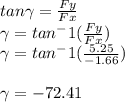
Two forces, F⃗ 1 and F⃗ 2, act at a point, as shown in the picture. (Figure 1) F⃗ 1 has a magnitude of 9.80 N and is directed at an angle of α = 58.0 ∘ above the negative x axis in the second quadrant. F⃗ 2 has a magnitude of 5.20 N and is directed at an angle of β = 52.4 ∘ below the negative x axis in the third quadrant.
Part A:What is the x component Fx of the resultant force?
Part B:What is the y component Fy of the resultant force?
Part C:What is the magnitude F of the resultant force?
Part D:What is the angle γ that the resultant force forms with the negative x axis? In this problem, assume that positive angles are measured clockwise from the negative x axis.

Answers: 3


Other questions on the subject: Physics

Physics, 22.06.2019 14:10, momo842
Your starship, the aimless wanderer, lands on the mysterious planet mongo. as chief scientist-engineer, you make the following measurements: a 2.50-kg stone thrown upward from the ground at 14.0 m/s returns to the ground in 5.70 s ; the circumference of mongo at the equator is 2.20×10^5 km ; and there is no appreciable atmosphere on mongo. (a) the starship commander, captain confusion, asks for the following information: what is the mass of mongo? (b) if the aimless wanderer goes into a circular orbit 2.20×10^4 km above the surface of mongo, how many hours will it take the ship to complete one orbit? (c) an unmanned spacecraft is in a circular orbit around the moon, observing the lunar surface from an altitude of 44.0 km . to the dismay of scientists on earth, an electrical fault causes an on-board thruster to fire, decreasing the speed of the spacecraft by 23.0 m/s . if nothing is done to correct its orbit, with what speed (in km/h) will the spacecraft crash into the lunar surface?
Answers: 1

Physics, 22.06.2019 22:00, steven2996
Aspaceship starting from a resting position accelerates at a constant rate of 9.8 meters per second per second. how far will the spaceship travel if its final speed is 1 percent the speed of light (300,000,000 m/s)? a. 3.1 × 106 m b. 2.94 × 108 m c. 7.8 × 1010 m d. 4.6 × 1013 m
Answers: 1

Physics, 23.06.2019 05:30, efraruiz02
Oxygen gas enters well-insulated diffuser at 25 lbf/in.2, 420r, with a velocity of 860 ft/s through a flow area of 1.6 in.^2. at the exit, the flow area is 12 times the inlet area, and the velocity is 19 ft/s. the potential energy change from inlet to exit is negligible. assuming ideal gas behavior for the oxygen and steady-state operation of the diffuser, determine the following: (a) the exit temperature, in r(b) the exit pressure, in lbf/in.^2 (c) the mass flow rate, in lb/s
Answers: 3
You know the right answer?
Two forces, F⃗ 1 and F⃗ 2, act at a point, as shown in the picture. (Figure 1) F⃗ 1 has a magnitude...
Questions in other subjects:

English, 07.03.2021 01:00

Biology, 07.03.2021 01:00


Mathematics, 07.03.2021 01:00


Spanish, 07.03.2021 01:00

Mathematics, 07.03.2021 01:00

Mathematics, 07.03.2021 01:00

English, 07.03.2021 01:00

Mathematics, 07.03.2021 01:00











